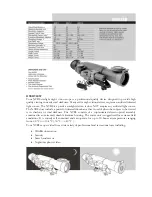
25
Event Menu
The Event menu provides access to dates and times of astronomical events. The Event data-
base includes:
Sunrise
and
Sunset
calculates the time that the Sun rises or sets on the current date. Find
rise and set times for other dates by entering a new date into the “Setup: Date” menu. See
DATE
, page 27.
Moonrise
and
Moonset
calculates the time that the Moon rises or sets on the current date.
Find rise and set times for other dates by entering a new date into the “Setup: Date” menu. See
DATE
, page 27.
Moon Phases
displays the date and time of the next Full, New, 1st Quarter, and 3rd Quarter
Moon.
Meteor Showers
provides information on upcoming meteor showers, such as the Perseids, the
Leonids,
etc.
Also lists the dates of the showers and when they reach maximum.
NOTE:
Meteor showers cover large areas of the sky and are usually best observed
with the naked eye.
Solar Eclipse
lists upcoming Solar Eclipses, including the date and type (total, annular, or par-
tial) of eclipse, and the location and time of the first and last contacts of the Moon's shadow.
Use the Scroll Up and Down keys to display the available data. Remember, never use a tele-
scope to look at the Sun! See “WARNING!” to the left.
Lunar Eclipse
lists upcoming Lunar Eclipses, including the date and type (total, partial,
penumbral) of eclipse. Use the Scroll Up and Down keys to display the available data.
Autumn
and
Vernal Equinox
calculates the time and date of the fall or spring equinox of the
current year.
Winter
and
Summer Solstice
calcu-
lates the time and date of the winter or
summer solstice of the current year.
Glossary Menu
The Glossary menu provides an alpha-
betical listing of definitions and descrip-
tions for common astronomical terms
and Autostar functions. Access directly
through the Glossary menu or through
hypertext words embedded in Autostar.
A
hypertext word
is any word in [
brack-
ets
], usually found when using the
Autostar Help function or when reading a
scrolling message such as a description
of a planet or star. Press ENTER when-
ever a hypertext word is on screen and
Autostar goes to the glossary entry for
that word.
To access directly from the Glossary
menu, use the Scroll keys to scroll
through the alphabet. Press ENTER on
the desired letter. Scroll to the desired
entry and then press ENTER to read the
description.
Utilities Menu
The Utilities menu provides access to
several extra features within Autostar,
including a countdown timer and an
alarm. The Utilities functions include:
TIPS
FOR BEGINNERS
•
Try to pick an observing site away from street
and house lights and car headlights. While this
is not always possible, the darker the site, the
better.
•
Give your eyes about ten minutes to adjust to
the darkness before observing. Give your eyes
a rest from observing every ten or fifteen min-
utes to relieve eyestrain.
•
Try not to use a standard flashlight. A lot of
observers use red LED flashlights or tape red
cellophane over their flashlights to use for
setup and map reading so they don’t have to
continually readjust their eyes to the darkness.
Be careful not to shine bright lights if there are
other observers in the area. Do not shine a
flashlight into the telescope while someone is
observing!
•
Dress warmly. It gets chilly when you’re sitting
for prolonged periods.
•
Practice setting up your equipment during the
day or in a lighted area to become familiar with
it before going to a dark site.
•
Use your 25mm eyepiece to view terrestrial
objects and wider areas of space, such as
open star clusters. Use your 9mm eyepiece
when you wish to view something up close,
such as craters on the Moon or the rings of
Saturn.
•
Know your observing site. If you’re going to try
out an unfamiliar site, check it out in the daylight
for possible obstructions and pitfalls.
Содержание ETX-80AT
Страница 1: ...Instruction Manual ETX 80AT BB Backpack Observatory MEADE COM...
Страница 2: ......
Страница 43: ......
















































